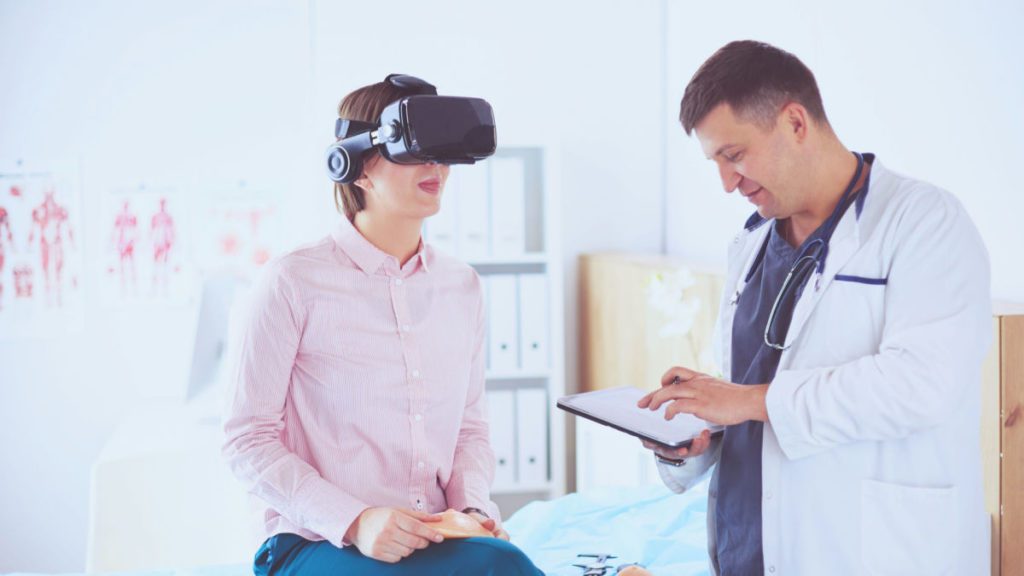Virtual reality (VR), the act of immersing users into a fully digital world through headsets, has been around for many years, and it’s only picking up steam. If you read MyMetaverseMinute, chances are you’re familiar with VR’s ups and downs as well as the many arguments around it and its role in the Metaverse.
A common concern is how VR impacts our health. As one of the most intimate technologies, (headsets strapped onto your face that feed directly to your eyes and ears), VR is something we should consider in a larger health context, especially as we spend more time working-from-anywhere and in the Metaverse. Much of the debate so far has been focused on physiological concerns like eye strain and headaches, but, as VR continues to play a more important part in our daily lives, the debate needs to expand to mental health and psychological impacts as well as how VR affects our schedules, habits, productivity, moods, relationships, and much more.
VR Risks
Let’s begin at the physiological level. I often hear: “Isn’t VR bad for your eyes? Don’t you get headaches and make your vision worse?” I can still hear my mother telling me not to sit too close to the TV — what she would think of VR displays, centimeters from your eyes, I can’t imagine.
But, the medical consensus is leaning in the other direction. Not only does VR not damage your eyes, but it might also even be better than traditional screens. Work from the American Academy of Ophthalmology has shown that, partly because VR mimics the way our eyes already work by showing each eye a slightly different image through two separate displays, allowing us to perceive depth, the technology may be used therapeutically to tackle vision-related issues like amblyopia (lazy eye), reaction time, eye coordination, depth perception, and hand-eye coordination.
In general, ophthalmologists agree that VR headsets do not permanently damage eye development, health, or function. However, VR can cause temporary pain or discomfort after prolonged, uninterrupted use. Often in the form of headaches, sore eyes, or dizziness, this phenomenon is usually called eye strain and can be caused by forcing the eyes to look at any screen, including smartphones and computers. This is because the eye is forced to focus on a single plane at a close distance for a prolonged time; we often forget to blink during screen time, causing dryness.
Another common VR concern is cybersickness, a close relative of motion sickness that is caused by the confusion among what your eyes see, what your brain understands, and what your body undergoes in virtual environments. Cybersickness is most common in VR games and experiences that involve lots of motion like flying, driving, or spinning, and it can be solved with the same remedies as motion sickness (fresh air, light snacks, water, and rest).
There are also concerns with VR use that are less proven. Some experts believe VR can create false memories in children twelve or younger, leading them to believe things happened in reality that were really in virtual reality. A BBC article on the topic brings up the “vergence-accommodation conflict,” or the disjunction between focusing on “distant” virtual objects while in reality focusing on a screen a few centimeters from your face. However, there are no studies that prove this conflict damages your eyes.
Regardless, you should not use VR without taking breaks — experts say a maximum of 30 minutes without break. Whether it’s to avoid eye strain or headaches, or just because heavy headsets are uncomfortable, you and especially your children should not be using them constantly. Also, make sure the headset straps, brightness, and calibration are well-adjusted.
Health Benefits of VR
But there’s another side to this coin. VR headsets can be beneficial to health in other ways. They are increasingly being used as therapeutic tools in senior homes, hospitals, therapist offices, and rehab centers. I used to intern for a company that streamlined the process of integrating VR into health professional practices and can attest that more and more institutions in the field are discovering VR’s power in medicine.
One interesting VR application is for pain management. A WebMD review pointed out that the distractions and pleasant environments produced by VR “eased pain for pregnant women who were in labor [and] helped children feel less pain and anxiety during a procedure to insert a catheter.” Some physical therapists also use this technology to help their patients tackle pain by immersing them in breathing-focused experiences in calming environments.
It can also be useful in mental health treatments. VR can give you a safe, controlled way to expose yourself gradually and repeatedly to situations that may cause anxiety or stress. Studies have shown this to help patients with acute phobias or even veterans and military personnel with PTSD (post-traumatic stress disorder). One common theme among all these examples is that VR remains only a piece of the treatment, always complemented by health professionals, talk therapy, mindfulness training, and other tools.
Final Thoughts
All in all, VR isn’t much different than regular screens when it comes to health impact. If you spend 12 hours a day working from home on Zoom, it will have a similar impact to spending all day locked into the Metaverse, sore eyes and aching heads included. As with most things, virtual reality should be experienced in moderation — hopefully, the Metaverse’s future creators will keep this in mind!
Want to compete in the Metaverse? Subscribe to the My Metaverse Minute Channel:










